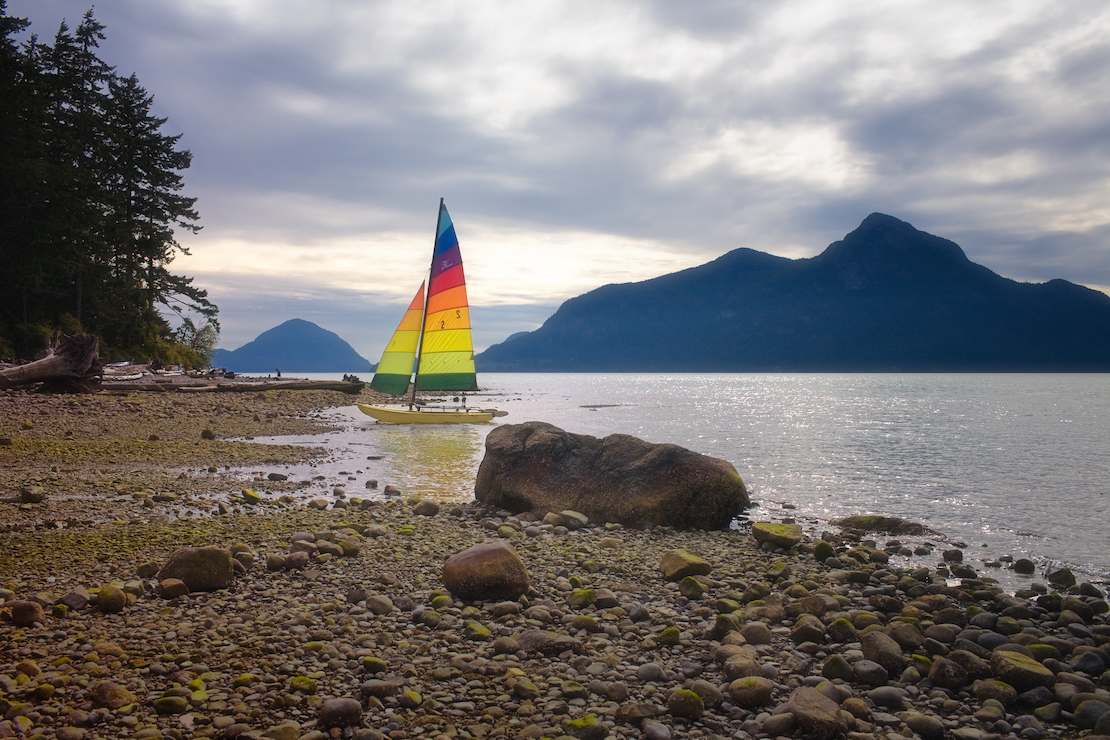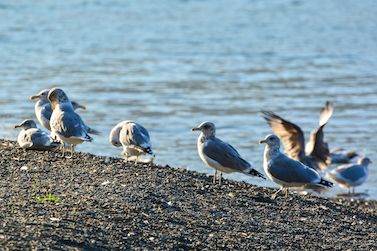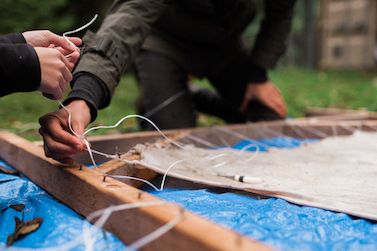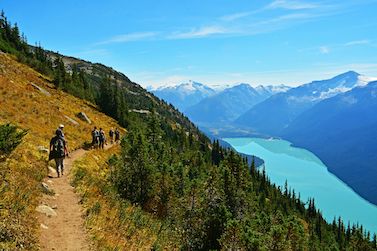British Columbia’s rugged coastline provides countless opportunities for adventure. If your passion is boating, swimming, hiking, or wildlife spotting, B.C.’s marine parks have what you’re looking for.
For more information on some of the most popular areas for aquatic activities, see marine recreation.
Indigenous Peoples have lived on the coast of what is now called British Columbia for thousands of years. Marine areas are potential archeological sites and remain important pathways and gathering places for First Nations.
These areas also contain many highly sensitive ecosystems and wildlife habitats. Marine activities often involve some personal risk. The information on this page will help you enjoy safe, sustainable, and respectful marine recreation.
Look below for information on:
- Respecting the Indigenous cultural values of marine areas
- Keeping yourself, your family, and other visitors safe
- Helping BC Parks protect sensitive wildlife habitats
- Maintaining water quality by minimizing pollution
- Behaving respectfully around marine wildlife
- Protecting native plants and animals
Rules and rangers
The advice provided here will help you take responsibility for behaving appropriately when visiting marine parks. Following these guidelines should ensure you do not break any BC Parks rules or provincial laws.
Park operators and rangers are responsible for implementing rules and laws in BC Parks. If you ignore the rules or break the law, they are required to act. For serious violations, you could be fined or evicted from the park.
Marine Recreation Action Plan
At BC Parks, we are committed to providing sustainable marine recreation opportunities. To help our staff meet this commitment, we have launched the Marine Recreation Action Plan (MRAP), which targets five key goals:
- Better understand the natural and cultural values of marine areas
- Strengthen relationships with First Nations coastal communities
- Provide high-quality marine recreation, today and in the future
- Enhance collaboration with other government agencies
- Promote ocean stewardship and responsible marine recreation
Respect Indigenous values
Marine areas are particularly important to many Indigenous Peoples. At BC Parks, we support the continued exercise of constitutionally protected rights to fishing and gathering in these areas. We ask that all visitors do the same.
When visiting marine parks, leave any cultural artefacts where you find them, including pot shards and arrowheads. Take extra care around pit houses and other heritage sites.
For more information on showing respect for Indigenous values, see Indigenous relations and reconciliation.
Practice water safety
Whether you are boating on the B.C. coast or just taking a dip at the beach, water safety is vital. It could save your life. Look in this section for tips that will help ensure your visit to a marine park is safe and fun.
Look here for information about:
Staying safe on a boat
If you are planning to operate a motorized boat, make sure you have a Pleasure Craft Operator Card. This is required for operators of boats with engines of any size or horsepower. That includes jet boats, boats with electric motors, and any sailboat fitted with an auxiliary motor, even if it is not used.
For information on how to obtain your Pleasure Craft Operator Card, visit the Transport Canada website.
Also, before setting out on any boat trip:
- If this will be your first boating experience, take a boating course to learn essential skills and safety procedures
- Make sure your boat has all the essential safety gear and enough fuel for your entire trip
- Check the weather and tides for areas you are visiting, and ensure these match your boat’s capabilities, and your own
- Leave a trip plan, including your scheduled return time, with a trustworthy friend or family member
During your trip:
- Within 30 m of the shore, observe Transport Canada’s shoreline speed limit of 10 km per hour (unless another limit is posted)
- Ensure that everyone in your party wears a lifejacket approved by the federal government
- Do not operate the boat if you are in any way impaired, and always travel at a moderate speed
Staying safe when swimming or visiting the beach
- Closely supervise young children near the water
- Watch out for strong currents and riptides
- Do not dive into shallow water
- Swim with a friend or family member, never alone
- Take extra care when the water is especially cold
To learn about cold-water risks and essential lifesaving skills, visit the Lifesaving Society of BC & Yukon website.
Care for sensitive habitats
B.C.’s marine parks encompass an extraordinary diversity of plant and animal life, often living in fragile ecosystems. Marine plants, such as kelp or seagrasses, provide important habitats for a wealth of wildlife, but are easily damaged.
All visitors should take care around marine ecosystems, but we ask boaters to be particularly careful. To make sure you do not have any negative impact on sensitive habitats during your next boating adventure:
- Never anchor in or motor through shallow water where kelp, seagrass, and other marine plants are abundant
- Use nautical charts, navigation equipment, and depth sounders to ensure you only anchor in water deeper than 10 m
- Use fixed moorings instead of anchors when stopping in or near kelp beds and seagrasses
- Land on beaches away from kelp beds or seagrass meadows, and avoid landing at extreme low tides
To learn more about protecting marine habitats, see respect wildlife, and protect native species, below.
Maintain water quality
Water is, of course, the defining feature of all marine parks. Nothing could be more important to the marine environment than maintaining water quality by minimizing pollution.
Crystalline water is an essential element of B.C.’s natural beauty, which draws people to our coastline, lakes, and rivers. Clean water is also essential to fish, seabirds, and other aquatic life.
At BC Parks, we are committed to helping keep B.C.’s water pristine for generations to come. You can help us by never putting garbage, human waste, or other pollutants into the ocean, lakes, and rivers.
To learn how you can help, look below to see:
Advice for boaters
- Dispose of garbage and recycling in receptacles at ports or take it home with you. Never dump garbage or discharge pollutants into the water.
- Use bilge cloths and pillows to collect engine oil, fuel, transmission fluid, and other pollutants.
- Avoid pumping sewage overboard, especially in anchorages, marinas, enclosed bays, narrow channels, sensitive habitats, or swimming areas.
To learn where you can and cannot discharge sewage, download Transport Canada’s complying with sewage discharge regulations [PDF] leaflet.
Advice for hikers
Use trash cans and toilets where they are available. In more remote areas, always follow Leave No Trace outdoor ethics. Pack out garbage and bury human waste 70 m from any water.
To learn more about Leave No Trace outdoor ethics, see the backcountry guide page.
Respect wildlife
British Columbia’s marine parks are home to everything from shellfish to killer whales. They are also important habitats for saltwater and freshwater fish and seabird colonies. To thrive, wildlife needs a clean, peaceful environment.
Use binoculars to view wildlife and only take pictures with a telephoto lens. Maintain regulated distances from marine mammals and bird colonies. Stay at least 100 m away, except in the following cases:
- 400 m from killer whales in southern BC coastal waters
- 200 m from killer whales elsewhere
- 200 m from whales, dolphins, and porpoises when resting or with calves
For more information on how to behave respectfully around marine mammals, visit the Government of Canada website.
Advice for boaters
- When passing an area with marine mammals, slow motors to minimize wake and engine noise
- Shut off any motors if approached by marine mammals, and wait until they pass safely, before resuming movement
- Navigate and steer carefully to avoid splitting up groups of marine mammals or trapping them near shore
- Respect rockfish conservation area closures to help protect declining populations of inshore rockfish species
To learn about keeping your family and pets safe around wild animals, see the wildlife safety page.
Protect native species
Invasive plant and animal life can pose a serious threat to native species. Boating activity can be a significant factor in spreading invasive species through marine ecosystems. To help us prevent the spread of invasive species:
- Clean all parts of your boat, trailer, and equipment (such as ropes, anchors, and fishing gear) when moving from one body of water to another
- Drain all parts of your boat and gear that can hold water on land before moving to a new location
- Ensure all items (such as fishing gear, ropes, and anchors) are completely dry before using them in a new location
To learn more about preventing the spread of invasive species in BC Parks, visit the invasive species page.




